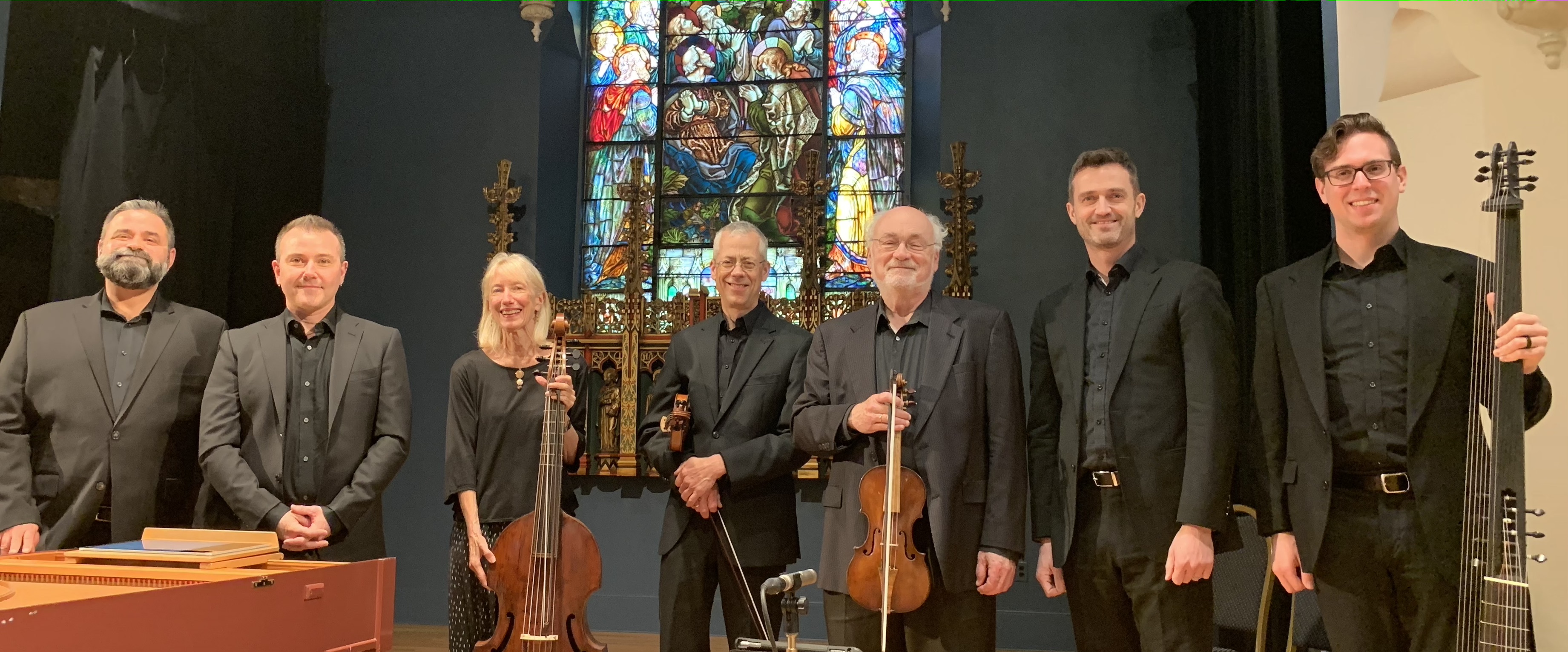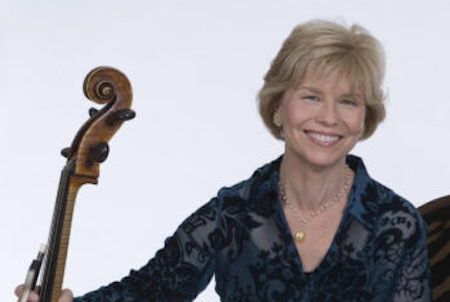Kristen Watson, soprano
Aldo Abreu and Christopher Krueger, recorders; Christopher Krueger, baroque flute; Danielle Maddon, Edson Scheid and Daniel Stepner, baroque violin;Laura Jeppesen, baroque viola ~ Loretta O’Sullivan, baroque cello; Andrew Arceci, violone; Peter Sykes, harpsichord
~~~
Canon and Gigue in D Major Johann Pachelbel (1653-1706)
Concert for sopranino recorder in A Minor Antonio Vivaldi (1678-1741)
Allegro – Larghetto – Allegro
Brandenburg Concerto No. 4 in G Major Johann Sebastian Bach (1685-1750)
Allegro – Andante – Presto
Intermission
Capriccio on the Departure of a Beloved Brother Bach
- Arioso: Friends gather and try to dissuade him from departing (Adagio)
- They imagine the dangers that might befall him (Andante)
- The friends lament (Adagiosissimo)
- As he cannot be dissuaded, they bid farewell (Andante con moto)
- Aria of the Postillion [coach-driver] (Allegro poco)
- Fugue in imitation of the Postillion’s horn
Cantata No. 209, « Non sa che sia dolore » (He does not know what sorrow is) Bach
Sinfonia — Recitative – Aria – Recitative — Aria
Bachianas Brasileiras No. 5 Heitor Villa Lobo (1887-1959)
Cantilena – Dansa (Martelo)
NOTES ON THE PROGRAM
Johann Pachelbel is one of those composers who has the dubious distinction of being known today for only one of his many works, the Canon in D Major, which is often played at weddings and, unfortunately, as recorded background music in public places, and even as a movie score (e. g. in the film Ordinary People). Its elemental, hypnotic bassline and the full texture of the canonic voices have even been coopted by various pieces of popular music in recent years. Like Samuel Barber’s beautiful Adagio for Strings, Pachelbel’s Canon was detached from its original setting. In the case of the Barber, the Adagio constituted the slow movement of a three-movement string quartet. Pachelbel’s wonderful Canon was the prelude to a Gigue which we happily restore tonight. In fact, Pachelbel composed hundreds of works – for organ, voice and chamber ensemble — and is esteemed among musicologists as one of the most important composers in the generation before Bach. He was friendly with the Bach family, for he spent some time in Eisenach, Johann Sebastian’s birthplace, though before the latter’s birth.
Vivaldi’s voluminous output of concerti and other works are discussed at length in the notes for the last concert on this series. Among his more than four hundred concerti are fifteen for flute, two for recorder and three for sopranino recorder.
Bach’s Fourth Brandenburg Concerto is scored for solo violin, two recorders, strings and continuo. He later transcribed it for two recorders, harpsichord solo and strings, paralleling his transcriptions of his other violin concerti for harpsichord solo. The concerto features the solo instruments if various combinations, and the accompanying ensemble has its own very detailed commentary. The first movement has the recorders in mostly parallel play while the violin solo takes some virtuoso turns. The second movement employs the three solo instruments as echoes to the larger ensemble’s phrases, and indulges in affecting chromatic lines. The finale begins as a strict fugue. Intervening episodes feature the soloists – once again giving the violin a real workout.
The Brandenburg Concerti as a set were dedicated to the Margrave of Brandenburg. Like the Musical Offering (dedicated to King Frederick the Great) and the B Minor Mass (to Augustus III), the dedications had little of the intended professional effect, but are today among the most popular of Bach’s prolific output.
* * * *
Bach’s Capriccio on the Departure of a Beloved Brother (BWV 992) was probably written as a tribute to his older brother Johann Jacob who went off to join the retinue of King Carl XII of Sweden. The original Italian (Capriccio sopra la lontananza del fratello dilettissimo) seems to denote a retrospective musing of leave-taking, since lontananza implies distance or remoteness, rather than departure. The Capriccio is one of the very few programmatic works by Bach, who was 18 or 19 when he composed it. It seems to have been influenced by Johann Kuhnau’s Biblical Sonatas, which attempt to depict scenes from the Bible, though Bach’s Capriccio has a touch of humor as well as the expected woe. The centerpiece is the lament, marked “Adagiosissimo,” a short chaconne in the austere key of F Minor. The pathos of this movement, like the prescribed tempo, is extreme, with keening, falling chromatic lines evoking weeping. (Interestingly, the repeating bass line is the same as that — transposed to D Minor — of Bach’s iconic Ciaccona for solo violin.) The mood picks up palpably in the subsequent movements, with the friends’ and relatives’ acceptance of the inevitable, and with the positively jolly evocation of the arrival of the horse-drawn coach that is to carry off the beloved brother.
Bach’s secular cantata “Non sa che sia dolore” is another farewell ode, though its date of composition and its exact intent is unclear. The Italian text (one of a very few Bach set) refers to Ansbach, a town in Bavaria that was under the aegis of the Margraves of Brandenburg from the mid-15th century on. The court had an Italianate culture, strengthened musically when the composer Giuseppe Torelli was appointed to the court in Ansbach in 1798. It has been conjectured that someone in Ansbach commissioned Bach to compose a valedictory ode to a departing figure at the court, perhaps an Italian returning home. The text seems to have been concocted by a German with limited Italian, as it is poetically awkward and at times opaque (translation enclosed). There is no surviving manuscript, as is the case with a number of other of Bach’s works whose authenticity is sometimes questioned. But the music itself can hardly have been composed by anyone else, and it has secured gained a place in Bach’s catalogue of works.
Heitor Villa-Lobos was born in Rio de Janeiro and was taught cello, guitar and rudimentary theory by his father, a librarian and an amateur astronomer and musician, who died suddenly when the budding composer was only twelve. His mother’s determination that he should become a doctor forced him look elsewhere to satisfy his musical hungers, and he learned and plied his musical trade on street corners, in silent movie houses, in cafes, and at wedding parties. Between the ages of 18 and 25 (1906-1912), he traveled extensively in Brazil, playing and collecting folk music from the fertile, rural mix of Portuguese, African and Amerindian cultures. Interestingly, this was precisely the period that Bela Bartok and Zoltan Kodaly were collecting Eastern European folk music in Hungary, Moldavia, Rumania, etc. Apparently, an ethnomusicological ethos was in the cultural air – a kind of rear-guard action, perhaps, against rapid industrialization and urbanization.
Villa-Lobos returned to Rio and tried to learn music and composition in standard, Eurocentric courses of study, but his independent streak was too strong. He was determined to create a Brazilian classical music based on the ethnic strands he found in his own country. He composed prolifically, played cello in local orchestras, and guitar in popular ensembles. He met musicians coming through Rio, including Darius Milhaud and Artur Rubinstein, who championed a number of Villa-Lobos’s piano works, and urged him to come to Paris — at that time the cultural capital of Europe. Between 1923 and 1930, he made his home in France. His avowed aim was to exhibit his own exotic sound world, rather than to study European music, and he had considerable success in presenting his highly individual concert music. But he also absorbed various influences, including Stravinsky, Debussy, Ravel, Milhaud, Satie, Strauss, and older masters, perhaps especially Bach. His best-known music – composed in the years after his return to Brazil from Paris — is a series of works for various ensembles, collectively entitled Bachianas Brasileiras. They are his response to the fashionable neoclassicism of the 1920s and 30s. The most frequently heard, the haunting Bachianas Brasileiras No. 5 for soprano and eight cellos (1938) – has become a kind of musical icon that straddles the classical and popular worlds. But the prolific composer also wrote operas, symphonies, solo piano music, solo guitar music, and chamber music, including seventeen string quartets.
Villa-Lobos’s return to Brazil coincided with the advent of the new nationalist regime, and he was put charge of organizing Brazilian musical life. Over many years, he carried out educational reforms much like those of Kodaly in Hungary. In 1945, he founded the Brazilian Academy of Music and nominated its first fifty members. Thus he had a long and profound effect in his native country: he created a national school of composition that was recognized in Brazil and abroad for its color and improvisatory energy.
~Daniel Stepner © 2019



